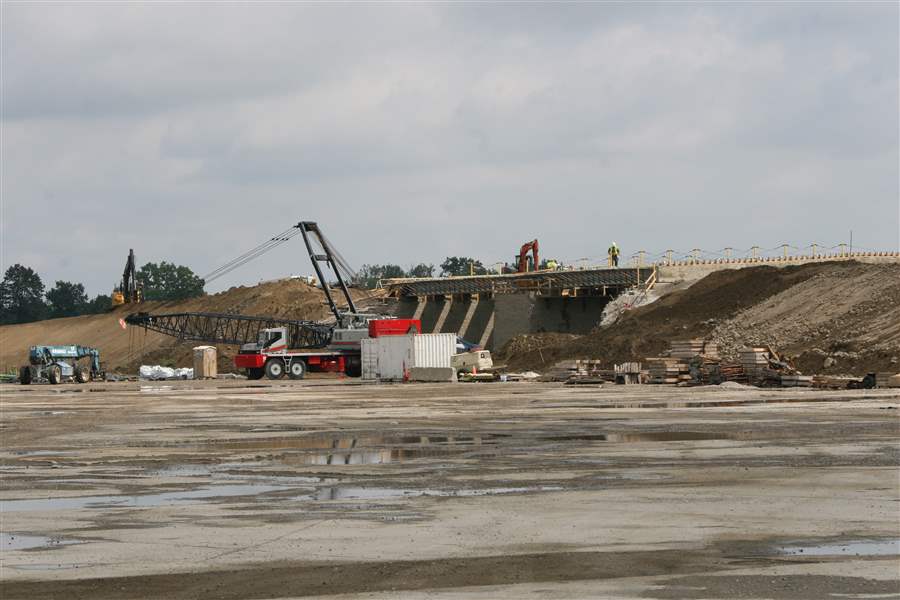
Legislators tour testing grounds for self-driving cars
8/15/2017
Construction progresses on an overpass along a 2-1/2 mile highway loop for automated-vehicle testing at the American Center for Mobility site near Ypsilanti, Mich. The section seen is being built atop part of the 5-million-square-foot concrete factory floor of the former GM Willow Run Transmission plant, originally built during World War II as a Ford B-24 Bomber plant. The $110 million project's plans call for construction of several different test environments for vehicle automation, including highway driving, urban driving, and rural driving.
THE BLADE/DAVID PATCH
Buy This Image
YPSILANTI, Mich. — Where tens of thousands once toiled to make transmissions for traditional human-driven vehicles — and before that, built World War II bomber planes — a testing ground for automated cars and trucks now is under construction.
The American Center for Mobility, a nonprofit corporation established early last year by the state of Michigan, expects a 2½ mile highway test loop across and near the grounds of the former General Motors Willow Run Transmission plant to be ready for use in December.
A second test facility representing urban driving conditions is slated for operation starting by the end of next year, and the $110 million project’s plans include future rural, residential, and even off-road test-driving areas.
ACM showed off the facility Tuesday to reporters after U.S. Reps. Bob Latta (R., Bowling Green) and Debbie Dingell (D., Dearborn) toured it and held a news conference to promote it and pending legislation they have co-sponsored to guide the development of national standards for automated vehicles.
The bill, approved unanimously (54-0) by the House Energy and Commerce Committee and expected to go to the House of Representatives floor next month, would allow automakers to deploy up to 100,000 self-driving vehicles that wouldn’t need to conform to current auto-safety standards and forbid states to establish performance standards for such vehicles.
Manufacturers would still need to certify automated vehicles’ proper function and safety to federal regulators under the bill.
“These [automated] vehicles are going to happen, and they’re going to transform mobility in the world,” said Mrs. Dingell, who warned that if the United States doesn’t take the lead, China, India, or western European nations will, “and we are not going to let that happen.”
“This is not government-driven” but is rather a collaboration of the private, public, and academic spheres to promote technological innovation and jobs growth in the Midwest, Mr. Latta said.
John Maddox, ACM’s president and chief executive, said the company so far has raised $91 million of the estimated full build-out cost from a mix of state and private — but not federal — sources.
While he balked at detailing those sources, Mr. Maddox noted a recent $5 million contribution from Toyota, which immediately gives that automaker access to the test site and a seat on its governing board.
The test center, he said, will fulfill a need for the United States “to develop a national laboratory asset, or national laboratories,” to work on vehicle automation, which is developing “even faster than they [the automotive industry] thought it would.”
Mark Chaput, ACM’s vice president of construction and infrastructure development, said the site is intended to be open to any player in the automation field — from automakers to sensor designers to software developers, as well as those seeking to establish system specifications and standards — to test their products.
“We’re basically trying to create as much real-world infrastructure as we can,” he said.
The facility is one of 10 federally designated proving grounds, he said, and among those perhaps four will have test tracks “of this nature.”
The ACM highway track is likely to be the only one with a tunnel, he said, and it also will incorporate part of nearby U.S. 12 built to handle factory traffic that vanished when GM closed its transmission plant 25 years ago.
Ford built the plant in 18 months during World War II to manufacture B-24 bombers, “and we’re trying to channel some of that speed as we build the American Center for Mobility,” Mr. Maddox said.
Besides making sure automation systems work, Mr. Latta and Mrs. Dingell said during their remarks, the pending bill directs the establishment of security standards to address the threat of hacking.
People who travel in automated vehicles will need confidence that they’ll go where they want to, “and in a safe manner,” Mr. Latta said, to which Mrs. Dingell added that the privacy of users’ vehicular data also is important.